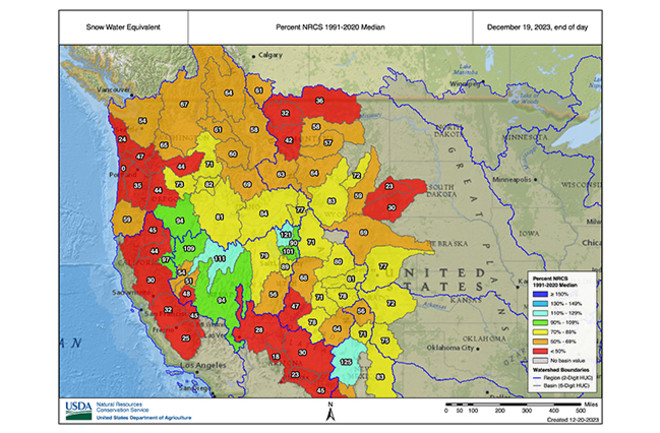Last year, as Christmas neared, a series of storms brought the drought-plagued western United States a gift of copious moisture. Parts of the region, in fact, were blanketed in double the normal snowpack.
This Christmas season, however, nature has been acting more like Scrooge than Santa Claus.
In the image above, the glaring tones of yellow, orange and red speak of a dramatic dearth of snow. Almost the entire region is far behind on moisture, with California's Sierra Nevada range in particularly bad shape.
Just how low we've sunk compared to last December is seen in this animation:
Satellite imagery reveals the same concerning picture of change:
On Dec. 15, 2022, California's Sierra Nevada Range — which runs diagonally across the images in the animation above — was buried under a thick blanket of snow, as were some of the state's coastal ranges, and a large portion of Nevada too. Almost exactly a year later, there's hardly any snow, except in the very highest elevations.
In the short run, a modicum of relief may be headed California's way. "A moderate risk (40 - 60 percent chance) of heavy precipitation is posted across parts of California next week," the National Weather Service said in an updated statement today. "Heavy snow is expected across the higher elevations of the Sierra Nevada."
But it will take a lot more than that for the entire region to catch up. For the southern tier of the western United States at least, El Niño continues to offer some hope that it will still turn out to be a good year for snow.
Thanks in part to what has grown into a strong El Niño, the odds slightly favor wetter than average conditions in California and the Colorado River Basin.
"El Niño is associated with specific changes to weather and climate around the world, and the stronger an El Niño, the more likely we are to see those impacts," writes the University of Miami's Emily Becker in NOAA's ENSO Blog. "Of course, nothing is ever guaranteed when it comes to our complex Earth system, and the unpredictable effect of chaos may interrupt the expected impacts."
Eyes on the Colorado
In the Colorado River Basin in particular, moisture is desperately needed. In this region, 40 million people living in seven states, Mexico and 30 tribal nations have been struggling to live with vastly diminished supplies of water thanks to overuse and megadrought. Last year they got a reprieve in the form of historic snowfall totals. This year, concerns are rising that the previous dry pattern will return. (Or maybe it's already here?)
Luckily, early in the winter season, recovery from snow drought can happen quickly, according to the latest drought status update from the National Integrated Drought Information System. So we still have plenty of time.
But the longer it takes for healthy snowfall to arrive, the harder recovery becomes. "Recovery from snow drought in late winter and early spring, when snowpack is typically near peak, can be more difficult," the drought status update states.
Let's hope that meteorological chaos does not intervene and that the current strong El Niño — expected to last through winter — will tilt the odds in favor of a wet winter in this region.
Which is another way of saying, "Let is snow, let it snow, let is snow..."

